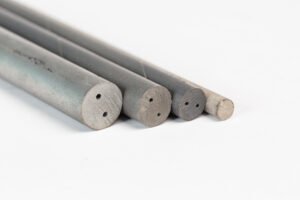Machine tools are the backbone of modern manufacturing, enabling the cutting, shaping, drilling, and finishing of various materials with precision. Whether in metalworking, aerospace, automotive, or general machining, these tools are essential for producing high-quality components.
While there are many specialized machine tools, seven fundamental types form the foundation of machining operations. Understanding these tools helps manufacturers select the right equipment for their applications and optimize production efficiency.
1. Lathe Machine – Turning and Shaping Cylindrical Parts
A lathe machine is one of the most commonly used tools for machining cylindrical and symmetrical parts. It rotates the workpiece while a cutting tool moves along its surface to remove material.
Key Operations:
- Turning: Reducing the diameter of a workpiece.
- Facing: Creating a flat surface on the end of a workpiece.
- Thread Cutting: Forming screw threads on a part.
Applications:
Used in the production of shafts, bushings, bolts, and aerospace components. CNC lathes provide high-precision automated operations.
2. Milling Machine – Multi-Directional Cutting for Complex Shapes
A milling machine removes material using a rotating cutting tool, which moves in multiple directions across a fixed workpiece. It is ideal for creating flat, contoured, and complex surfaces.
Key Operations:
- Face Milling: Cutting a flat surface on the top of a workpiece.
- End Milling: Creating slots, pockets, and contours.
- Drilling and Boring: Making and enlarging holes precisely.
Applications:
Used in automotive, aerospace, and mold-making industries for precision machining of engine parts, molds, and dies.
3. Drilling Machine – Creating Precise Holes
A drilling machine is designed to make holes in metal, wood, or plastic using a rotating drill bit. It can be manual, semi-automatic, or CNC-controlled for high precision.
Key Operations:
- Drilling: Making straight holes into a material.
- Reaming: Refining a hole to improve its accuracy.
- Tapping: Cutting threads inside a hole for screws or bolts.
Applications:
Essential for metalworking, construction, and electronics industries, widely used in fixture making, aerospace, and mechanical engineering.
4. Grinding Machine – High-Precision Finishing and Surface Smoothing
A grinding machine is used for precision finishing, removing small amounts of material to achieve smooth surfaces and tight tolerances. It works by rotating a grinding wheel against the workpiece.
Key Operations:
- Surface Grinding: Flattening a surface for high-precision applications.
- Cylindrical Grinding: Machining round objects like shafts.
- Tool & Cutter Grinding: Sharpening cutting tools for extended life.
Applications:
Used in tool making, aerospace, and automotive industries for finishing engine components, cutting tools, and gears.
5. Shaper Machine – Linear Cutting of Flat Surfaces
A shaper machine is designed to cut straight, flat surfaces using a reciprocating cutting tool. Unlike milling machines, it uses a single-point tool that moves back and forth.
Key Operations:
- Flat and angular surface machining.
- Keyway and slot cutting.
- Internal surface shaping.
Applications:
Common in gear manufacturing, die making, and metal fabrication. Less used today due to advanced CNC milling machines.
6. Planer Machine – Large-Scale Machining of Flat Surfaces
A planer machine is similar to a shaper but designed for larger workpieces. Instead of moving the tool, the workpiece moves back and forth under a stationary cutting tool.
Key Operations:
- Precision machining of large flat surfaces.
- Heavy-duty cutting for large castings and structural components.
Applications:
Used in shipbuilding, heavy machinery, and industrial equipment manufacturing. CNC and milling machines have largely replaced it in modern factories.
7. Broaching Machine – Highly Precise Internal and External Cutting
A broaching machine uses a multi-toothed cutting tool (broach) to remove material in a single pass, making it ideal for high-precision, repetitive machining.
Key Operations:
- Internal Broaching: Cutting keyways, splines, and precision holes.
- Surface Broaching: Producing flat or contoured surfaces with high accuracy.
Applications:
Common in automotive, aerospace, and defense industries, used for making gears, keyways, hydraulic components, and firearm parts.
Conclusion: Choosing the Right Machine Tool for Your Needs
Each of these seven basic machine tools plays a vital role in manufacturing, precision engineering, and metalworking. Choosing the right machine depends on:
- The type of material being machined.
- The complexity and precision of the workpiece.
- Production volume and cost efficiency.
At Zhuzhou Zhirong Advanced Materials Co., Ltd., we specialize in high-performance tungsten carbide cutting tools for CNC lathes, milling machines, drilling machines, and grinding operations. Our tungsten carbide inserts, end mills, and cutting tools are made from 100% virgin carbide powder for superior wear resistance and precision machining.
For expert advice on selecting the best cutting tools for your machine tools, contact us at crystalyuan@zrzhirong.com or visit www.zhirongcarbide.com. We also provide free samples for testing and evaluation.




